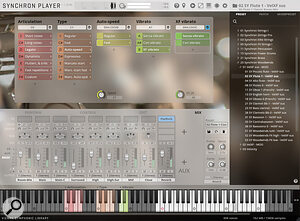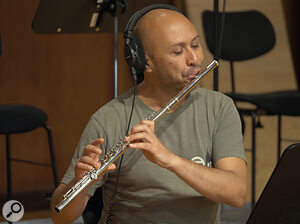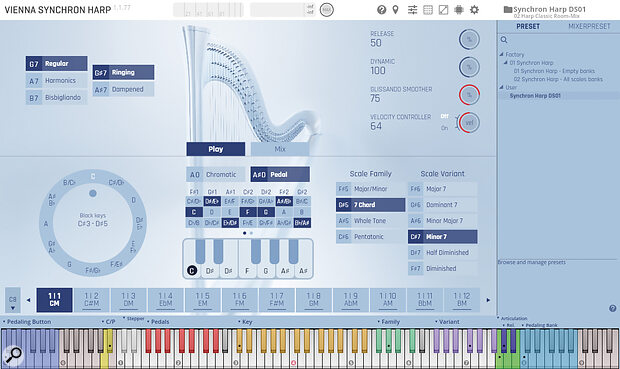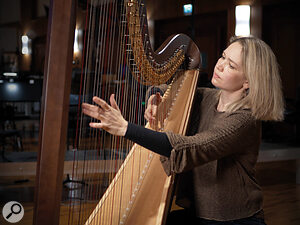The addition of woodwinds, a third percussion collection and concert harp sees VSL’s Synchron Orchestra reach maturity.
Energy prices go through the roof, global warming spins out of control, UK prime ministers come and go and the cost of a Royal Mail first‑class stamp steadily rockets, but some things never change. Ensconced in their state‑of‑the‑art concert hall, VSL continue to record new orchestral samples, adding further instruments, ensembles and voices to their vast symphonic stockpile. Since acquiring the Synchron Stage (formerly Synchronhalle) in 2013 the company set their sights on creating a complete hall‑recorded orchestra to stand alongside their Vienna Instruments series. Now, the addition of woodwinds, harp and a third percussion collection to the Synchron range has seen them achieve that goal.
 The Vienna Synchron Player’s colour‑coded switching system shows all available articulations for an instrument with corresponding coloured keyswitches enabling on‑the‑fly musical changes.Apart from the imposing hall acoustic, the chief difference between the earlier Vienna Instruments libraries and the Synchron series is the latter’s multiple mic positions. All Synchron orchestral libraries include Close, Mid, Decca Tree Stereo, Decca Tree Mono (centre), Main Surround, High Stereo (3D) and High Surround (3D) positions. When buying a Full library you’ll get all seven, enabling mixes in up to 9.1 surround and immersive audio formats such as Auro 3D and Dolby Atmos. Alternatively, you can make considerable savings by buying the Standard version, which omits the last three positions with no detriment to sound quality.
The Vienna Synchron Player’s colour‑coded switching system shows all available articulations for an instrument with corresponding coloured keyswitches enabling on‑the‑fly musical changes.Apart from the imposing hall acoustic, the chief difference between the earlier Vienna Instruments libraries and the Synchron series is the latter’s multiple mic positions. All Synchron orchestral libraries include Close, Mid, Decca Tree Stereo, Decca Tree Mono (centre), Main Surround, High Stereo (3D) and High Surround (3D) positions. When buying a Full library you’ll get all seven, enabling mixes in up to 9.1 surround and immersive audio formats such as Auro 3D and Dolby Atmos. Alternatively, you can make considerable savings by buying the Standard version, which omits the last three positions with no detriment to sound quality.
Individual mic positions are available as separate channels in the mixer section of the free Vienna Synchron Player, along with a suite of built‑in effects and a large selection of mixer presets ranging from naturalistic to heavily processed. Before you ask, there’s no Kontakt version, and never will be — with these samples, the Synchron Player is the only game in town.
Synchron Woodwinds, Synchron Percussion III and the delectable Synchron Harp put the seal on a great body of work which can now take its place among the ranks of elite sampled symphonic orchestras.
For users who haven’t heard the news, it’s worth noting that in August 2021 VSL switched their licence protection system from eLicenser to iLok. You can read more details in the box below, and I’d also recommend that prospective buyers check out the company’s news page. In the meantime, we’ll take a look at each of the three instrument collections which collectively bring VSL’s Synchron Orchestra to full fruition.
Synchron Woodwinds Overview
Sounding confident and secure in their natural recording habitat, the Synchron Stage Orchestra’s woodwinds consist of 13 newly recorded solo instruments and seven pre‑existing ensembles. As with the old VI series, there’s a choice of two solo flutes, two oboes, two Bb clarinets and two bassoons, but as yet no supplementary instruments such as bass flute, clarinet in Eb and contrabass clarinet. My covert VSL intelligence source tells me these extras will “most probably” be added at some point, but not in the near future. If you need one of those instruments in a hurry, they’re still available as Vienna Instruments single downloads.
The woodwind ensembles were airlifted in from VSL’s affordable, easy‑to‑use Big Bang Orchestra series, which kept Vienna followers entertained through the dark days of lockdown. BBO Orion’s three‑player flute, oboe, clarinet and bassoon ensembles adopt the classic format of Miroslav Vitous’ trailblazing 1993 Symphonic Orchestra woodwind trios, but as you’d expect 20 years on, the Orion samples offer a lot more in the way of articulations, dynamic depth and overall performance usability.
Featuring a pre‑orchestrated live ensemble of 13 players, BBO Neptune’s tutti woodwind section perform a menu of common styles over a full A#1‑D6 range, giving you a perfectly blended symphonic sound at the touch of a finger. For further musical gratification entailing minimal effort, the played octave runs, arpeggios, cluster chords and swells taken from BBO Solaris dish up instant orchestral colour and drama. These ensembles follow the standard Synchron miking scheme and correspond exactly to their previously issued Big Bang Orchestra incarnations. Accordingly, anyone who already registered one or more of them will get a crossgrade discount when purchasing the Synchron Woodwinds Standard or Full Library. The latter requires 182.4GB of free storage space, while the Standard Library requires 109.9GB.
 Synchron Woodwinds’ elaborate microphone set up, showing surround and height mics at the rear.
Synchron Woodwinds’ elaborate microphone set up, showing surround and height mics at the rear.
Solo Woodwinds
Having enjoyed playing VSL’s solo woodwinds since Mark Wherry and I reviewed the company’s “unprecedentedly vast” First Editions back in May 2003, I was curious to hear how the new Synchron instruments compare to their Vienna Instruments forerunners. The short answer is, very well. I was impressed by the library’s oboes: Oboe 1 manages to sound dulcet while retaining the instrument’s penetrative timbre, while Oboe 2 is a touch more assertive and brighter‑sounding. Both sound great. Filling out the low oboe range, a hugely playable English horn played by Alejandra Piegala is a formidable expressive lead instrument in its own right — I particularly liked its legato ‘marcato start fast’ artic, which enables you to articulate and emphasise note attacks within a flowing legato melody.
I was never a fan of VSL’s original solo clarinet, complaining in the 2003 SOS review about its relative lack of playability. Given the company’s impeccable reputation this always seemed something of an anomaly, so I’m pleased to say that the new pair of Bb clarinets have dispelled my historic gripes. The first instrument has a beautiful smooth tone, and its player Wolfgang Klinser performs liquid gliding legatos, mellifluous trills and astonishingly precise fast note repetitions. The second clarinet also turns in impressively accurate and expressive performances. Both instruments are played in the traditional no‑vibrato orchestral style — a vibrato option (as in VSL’s earlier Clarinet 2 single instrument) would have been nice, but I guess you can’t have everything.
While Flute 1 is perfectly serviceable and playable, I preferred the lyrical, plaintive tone and faster‑speaking vibrato of Veronika Vitazkova’s Flute 2. A stellar alto flute generously extending to a low F3 has glorious low notes and is equally blessed with a heavenly high register, so you can happily use all three instruments for three‑part flute inventions. With the two bassoons, the pecking order is reversed — Lisa Maria Kogler’s Bassoon 1 sounds imperious, big, bright and bold, while Bassoon 2 is softer and more laid back, better suited to supporting parts.
 Flute, alto flute and piccolo player Boris Lipov.Of the remaining instruments, my favourite is the bass clarinet — its superbly deep, rounded tone is a joy and, when required, its quicksilver legato delivery can be just as nimble as the Bb clarinets’. The library’s fine‑toned contrabassoon contributes some great, stentorian room‑shaking long notes but its clipped, ultra‑short staccatissimo style sounds unmusical. As ever, for those keen on flatulent humour, its flutter‑tongue marcatos are a good laugh. Meanwhile at the opposite end of the pitch spectrum, I enjoyed the piccolo’s tuneful and pure‑sounding high register. The instrument was played by the versatile Boris Lipov, who also brought us Flute 1 and the excellent alto flute.
Flute, alto flute and piccolo player Boris Lipov.Of the remaining instruments, my favourite is the bass clarinet — its superbly deep, rounded tone is a joy and, when required, its quicksilver legato delivery can be just as nimble as the Bb clarinets’. The library’s fine‑toned contrabassoon contributes some great, stentorian room‑shaking long notes but its clipped, ultra‑short staccatissimo style sounds unmusical. As ever, for those keen on flatulent humour, its flutter‑tongue marcatos are a good laugh. Meanwhile at the opposite end of the pitch spectrum, I enjoyed the piccolo’s tuneful and pure‑sounding high register. The instrument was played by the versatile Boris Lipov, who also brought us Flute 1 and the excellent alto flute.
With the exception of the clarinets, all of the Synchron solo woodwinds play regular, marcato and espressivo sustains and long portatos with and without vibrato — you can crossfade between their no‑vibrato and vibrato performances; a nice expressive device. The legatos have an optional marcato attack and an auto‑speed option which selects authentic note transitions depending on your playing speed. For more rhythmic work, the short and long staccatos and short portatos have ‘bold’ and ‘agile’ variants, while VSL’s traditional sforzato, sforzatissimo, crescendo, diminuendo, flutter tongue, trill and fast note repetition artics are all present and correct. Due to the miracles of modern science, you can now use integrated time‑stretching to fit the repetitions to your project tempo.
Woodwind Ensembles
Despite their origins as inexpensive, user‑friendly sound packs, there’s nothing cheap or amateurish about Synchron Woodwinds’ ensembles — they sound great, and contain some excellent material. The 13 tutti woodwinds’ and three‑player flute, clarinet and bassoon ensembles’ long notes sound sumptuous, and while three unison oboes sound shrill when played loud, they can add a brilliant trumpet‑like edge to woodwind arrangements. All performances are bang in tune, underlining the value of owning your own recording facility — if a player fluffs a note, there’s always time for another take!
I enjoyed the tutti woodwinds’ palatial quiet sustains and tight, motoring note repetitions, the latter played in a choice of four tempos. All good stuff, but as mentioned earlier, the most attention‑grabbing artics reside in the so‑called ‘FX Woodwinds’ taken from BBO Solaris. A 10‑player high‑woodwind ensemble performs ascending and descending octave runs in all 12 keys with a variety of starting notes, offering a choice of scales comprising major, minor, chromatic, whole‑tone and five modal scales with intimidating names — Phrygian mode, anybody? The high woodwinds also play a full set of triplet‑based triadic arpeggios in three tempos featuring eight common chord types. You can set the arpeggio direction to up, down or ‘cross’ (simultaneous up and down), the latter creating a great, chaotic swirling effect.
Underpinning these animated performances is a low‑winds section of bassoons, contrabassoons, contrabass clarinet and two bass clarinets. Voiced in octaves, these guys sound like they mean business, honking out menacing sforzatissimos and growling flutter tongues. Media composers engaged in horror productions will also appreciate the section’s three‑semitone cluster chords, an atonal effect widely used in 1960s scary British film scores. All of the above ensembles include individual close mics for each instrument family, giving you enhanced control of your woodwinds mix.
Synchron Percussion III
Released in April 2017, Synchron Percussion I was the first library to be recorded at VSL’s Synchron Stage, with Synchron Percussion II following in July 2020. Both collections are divided into Timpani, Drums, Cymbals & Gongs, Mallets, Bells, and Orchestral Percussion sections, all of which can be purchased separately in Standard or Full Library formats. Synchron Percussion III adds a total of 48 new instruments and ensembles across the six categories. This third and final collection’s Full Library is 229.6GB installed, or you can buy the Standard version and save yourself 103GB of disk space and about 250 quid.
SPIII’s new samples feature the same five timpani drums found in SPI and SPII, this time played with hard mallets for a more martial effect. The timps sound clean enough to eat your dinner off and tolerably powerful, but if you’re after the archetypal battering cinematic drums racket you’d do better to use the percussion ensemble’s hits and riffs drafted in wholesale from the Big Bang Orchestra libraries Dorado and Eridanus. These feature a six‑player percussion ensemble bashing hell out of Monster Drums (large taikos, orchestral bass drums and surdos), Bass Drums (including more taikos) and Thunder Toms. While you’re at it, you’ll probably want to add the triumphal piatti splashes of ‘Super Crashes’, rousing marching snares, doomy field drums and the hellish clang of tam tam gongs, plate bells and anvil, ideally not at a time when an aged relative is asleep in a neighbouring room.
One item conspicuously missing from previous Synchron Percussion titles is the marimba. Five years is a long time to wait for such an essential sonority, but it was worth it — this five‑octave Adams model is a gem of an instrument, whether played with soft mallets to create gently propulsive bubbling ostinato passages or using the characteristic incisive hard mallet sound for accented riffs and patterns. VSL went to town and sampled multiple articulations at up to eight dynamics with nine or so round robins, resulting in a supremely charismatic and organic‑sounding marimba — in a word, beautiful.
Other patches which caught my ear include a nice set of cloppy tuned temple blocks, tuned cowbells known as cencerros (search for ‘Spike Jones Chloe’ and you’ll get the idea), some pretty chromatic hand bells and an ethereal set of rin bells, a resonant metal bowl used in Buddhist meditation. Added to these otherworldy chimes are exotic high and low bells ensembles taken from BBO Fornax and a large miscellany of orchestral and Latin percussion including congas, timbales, claves, wind chimes, car horns, bird calls and slide whistles, the last three of which would come in handy if you fancy recording your own version of ‘Chloe’.
For more details of the BBO Dorado, Eridanus and Fornax libraries and the first two Synchron Percussion collections, see their respective reviews in the September 2020 and May 2021 issues of SOS, both of which can be read online.
Synchron Harp
 The ingenious Synchron Harp Player design replicates the harp’s pedalling system, enabling you to perform glissando sweeps on the keyboard white notes in a scale or chord variant of your choice. Alternatively, you can play it chromatically.
The ingenious Synchron Harp Player design replicates the harp’s pedalling system, enabling you to perform glissando sweeps on the keyboard white notes in a scale or chord variant of your choice. Alternatively, you can play it chromatically.
If one were allowed to bring sampled instruments in as hand luggage at the Pearly Gates, one I’d be sure to pack would be the original Vienna Instruments Harp. This superb sonority was eventually joined by a second VI harp of identical quality, causing a severe deterioration of my work rate since I could never decide which one to use! With the release of Synchron Harp, my dilemma just got worse — this Lyon & Healy Concert Grand harp also sounds fantastic. Maybe I’ll just have to toss a coin?
 Synchron Stage Orchestra harpist Tina Žerdin’s YouTube video offers useful tips to composers writing for harp.Played by long‑time Synchron Stage Orchestra harpist Tina Žerdin, the Synchron Harp has its own dedicated software player. A glance at the controls shows why this was necessary — in order to replicate the complex pedalling mechanism which determines the pitch of the harp’s 47 strings, VSL created an ingenious Pedal Mode allowing you to replicate all possible real‑life tunings by means of seven keyswitches corresponding to the seven harp pedals. You can then use your keyboard’s white notes to perform real‑time glissando sweeps in whatever scale you choose, with common scale types and chordal variants available as presets. Alternatively, you can select Chromatic Mode and play the harp freely like a keyboard instrument.
Synchron Stage Orchestra harpist Tina Žerdin’s YouTube video offers useful tips to composers writing for harp.Played by long‑time Synchron Stage Orchestra harpist Tina Žerdin, the Synchron Harp has its own dedicated software player. A glance at the controls shows why this was necessary — in order to replicate the complex pedalling mechanism which determines the pitch of the harp’s 47 strings, VSL created an ingenious Pedal Mode allowing you to replicate all possible real‑life tunings by means of seven keyswitches corresponding to the seven harp pedals. You can then use your keyboard’s white notes to perform real‑time glissando sweeps in whatever scale you choose, with common scale types and chordal variants available as presets. Alternatively, you can select Chromatic Mode and play the harp freely like a keyboard instrument.
The harp has three essential articulations: regular plucks, harmonics and bisbigliando (tremolo), each with a ringing and dampened option. Its sound is gorgeously luxuriant, deeply dynamic and affective, a lovely, immaculately played instrument captured in a superior recording space. Highly recommended. Synchron Harp’s Standard Library requires 55.3GB of disk space, while the Full Library eats up 92.2GB.
Conclusion
There you have it. Though the Synchron Orchestra will no doubt organically expand in future in the manner of its multi‑tentacled Vienna Instruments predecessor, VSL now have a second ready‑to‑go complete symphonic collection, recorded in a hall praised by luminaries such as Hans Zimmer and Conrad Pope for its outstanding acoustics. Synchron Woodwinds, Synchron Percussion III and the delectable Synchron Harp put the seal on a great body of work which can now take its place among the ranks of elite sampled symphonic orchestras.
Synchron Woodwinds Instrumentation
Solo Woodwinds
- Piccolo
- Flute 1
- Flute 2
- Alto flute
- French oboe 1
- French oboe 2
- English horn
- Clarinet in Bb 1
- Clarinet in Bb 2
- Bass clarinet
- Bassoon 1
- Bassoon 2
- Contrabassoon
Woodwind Ensembles
- Three flutes*
- Three oboes*
- Three clarinets*
- Three bassoons*
- Tutti woodwinds (13 players)*
- Low FX woodwinds (eight players)*
- High FX woodwinds (10 players)*
* Also included in VSL’s Big Bang Orchestra series.
Synchron Percussion III Instrumentation
Drums & Cymbals
- Timpani (hard mallets)
- Snare drum
- Marching snare
- Field drum
- Piccolo snare
- Boobams
- Piatti
- Sizzle cymbal
- Splash cymbals [2]
- Ancient cymbals
Ensembles (from BBO Eridanus)
- Drum ensemble riffs
Ensembles (from BBO Fornax)
- Big timpani ensemble
- Drums & pianos ensemble
- Low bells & pianos ensemble
- High bells ensemble
- High gongs ensemble
Ensembles (from BBO Dorado)
- Monster drums ensemble
- Bass drums ensemble
- Thunder toms ensemble
- Special drums ensemble
- Snare ensemble
- Suspended cymbal ensemble
- Super crashes ensemble
- Big metal ensemble
- Small metal ensemble
Tuned Percussion
- Marimba
- Temple blocks
- Cencerros
- Hand bells
- Rin bells
Latin Percussion
- Congas
- Bongos
- Timbales
- Cow bells
- Agogo bells
- Guiros
- Sandpaper blocks
- Claves
- Cabasas
- Wind chimes
Unpitched Percussion
- Jingle bells
- Flexatones
- Car horns
- Horns & sirens
- Whistles
- Bird calls
- Slide flutes
- Jingle ring
Hello iLok
Having used eLicenser dongle‑based protection for many years, VSL began to transition all their products to PACE’s iLok licence management system after Steinberg ditched eLicenser in March 2022. For existing VSL users, moving licences from eLicenser to iLok is free of charge, and you can choose between an iLok hardware key or iLok Cloud licence storage.
VSL say that eLicenser‑protected software and library products will keep on working on existing systems. However, it’s not possible to run iLok and eLicenser versions on the same computer, so you have to decide which copy protection you want to use. Furthermore, due to changes in the sample encryption existing users wishing to move to iLok will need to re‑download the iLok‑protected sample content of all their licensed products along with the associated sample player software. The company’s new Vienna Assistant software will help with this task.
Owners of large Vienna sample collections who can’t face re‑downloading their libraries may wish to consider buying the 4TB VSL Hard Drive (€195), which contains the library installation files (though not the licences) for all current VSL products.
Pricing
- Synchron Woodwinds: Standard Library €595, Full Library €850.
- Synchron Percussion III (All): Standard Library €395, Full Library €690.
- Synchron Timpani III, Mallets III, Cymbals & Gongs III: Standard Libraries €95 each, Full Libraries €165 each.
- Synchron Drums III: Standard Library €115, Full Library €195.
- Synchron Bells III, Orchestral Percussion III: Standard Libraries €75 each, Full Libraries €135 each.
- Synchron Harp: Standard Library €195, Full Library €345. Prices include VAT.
Pros
- Synchron Woodwinds is a superior hall‑recorded collection of solo instruments and ensembles.
- The woodwinds’ musically intelligent true legato mode (which VSL invented) creates superbly realistic melody lines.
- Synchron Percussion III adds cinematic drums, a superb marimba and exotic bells to the percussion menu.
- Synchron Harp is to die for.
- All three libraries benefit from elaborate multi‑miking and a top‑class, sumptuous hall acoustic.
Cons
- In my experience the installation process can be very slow.
- The Full collections are pricey — but do you really need those extra mic positions?
Summary
Now boasting a woodwinds library comprising 13 solo instruments and seven ensembles, a third and final percussion collection and a gorgeous concert harp, VSL’s Synchron Orchestra is a comprehensive tool for all composers and music producers who require high‑class orchestral samples. Perfectly played, bang in tune, musically detailed and bathed in a splendid hall acoustic, the three latest Synchron libraries maintain VSL’s exemplary standards.

